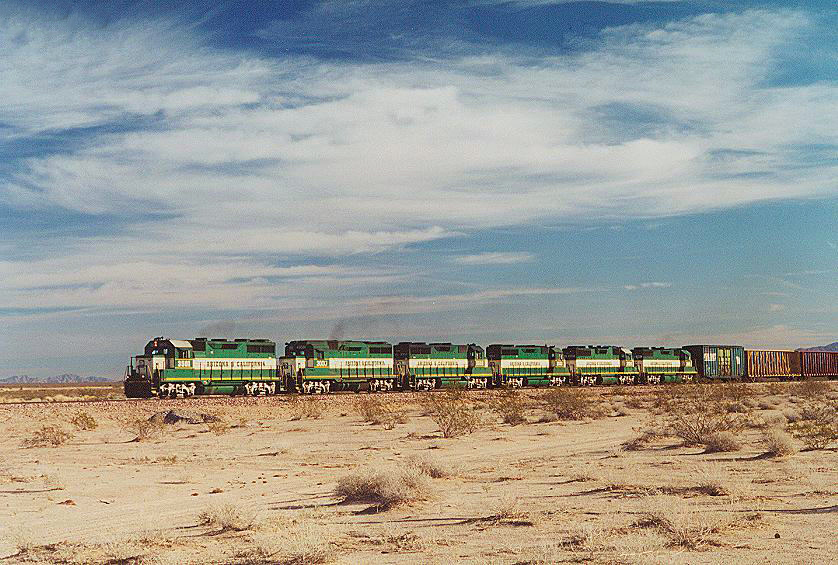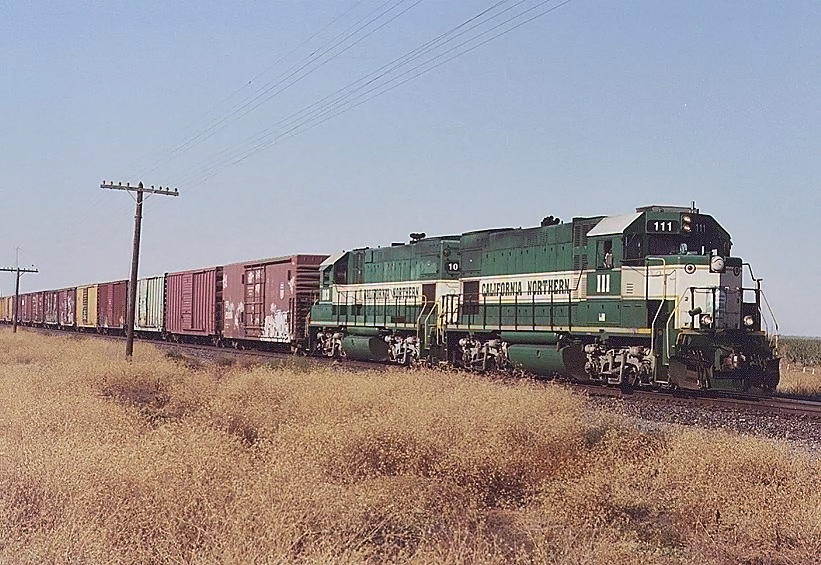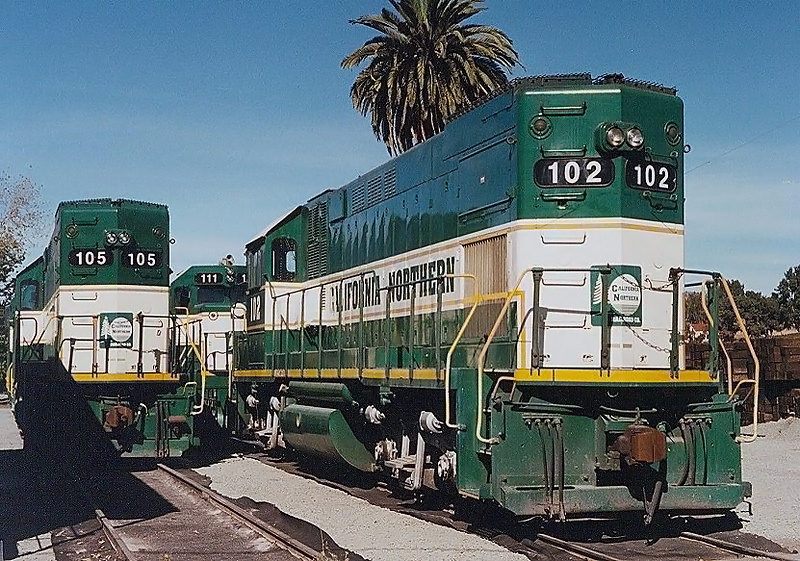ParkSierra Railgroup: A Small Short Line Contingent
Published: August 7, 2024
By: Adam Burns
ParkSierra Railgroup was founded by David Parkinson in 1991 when it acquired a former Santa Fe line in 1991. The 262-mile line linked Cadiz, California with Phoenix, Arizona.
During the next decade the group launched the California Northern Railroad (1993) over former Southern Pacific trackage and the Puget Sound & Pacific (1997), which operates in Washington's Olypmic Peninsula (ex-SP).
All three of ParkSierra's railroads were adorned in a common livery of deep green with a large white stripe and yellow trim. Parkinson's collection of short lines likely would have continued to grow if not for the group's acquisition by RailAmerica in late 2001, which was finalized in January, 2002. RA itself was acquired by Genesee & Wyoming in 2012.
 Several Arizona & California Geep's, led by GP35 #3501, head westbound across the barren Mojave Desert in southeastern California on February 18, 2001. Doug Kroll photo.
Several Arizona & California Geep's, led by GP35 #3501, head westbound across the barren Mojave Desert in southeastern California on February 18, 2001. Doug Kroll photo.History
ParkSierra Railgroup was a prominent player in the short line movement which sprang up in the latter 1980s through the 1990s. This privately-held company excelled in providing customized freight rail solutions, primarily operating in regions where it could serve smaller, niche markets that larger Class I railroads often overlooked.
One of the crown jewels in ParkSierra's portfolio was the California Northern Railroad (CFNR). This line spanned several counties in Northern California, offering essential freight services to industries ranging from agriculture to manufacturing. The CFNR was crucial in moving goods such as wine, agricultural produce, lumber, and industrial chemicals, making it a vital economic link in the area.
Another significant asset under ParkSierra's management was the Puget Sound and Pacific Railroad (PSAP), operating in the state of Washington. The PSAP was pivotal in serving the timber and forest products industries, in addition to providing access to key port facilities, thereby supporting the region's export-driven economy.
Adding to its diverse portfolio, ParkSierra also operated the Arizona and California Railroad (ARZC). This line navigated through challenging terrains to connect California's agricultural heartland with Arizona.
The ARZC played a vital role in transporting goods such as grains, petroleum products, and other bulk commodities, providing essential connectivity between remote areas and major distribution centers.
ParkSierra was not just about moving goods; it was dedicated to fostering strong relationships with its customers, many of whom were smaller businesses that depended on reliable and flexible rail service. By focusing on personalized service and operational efficiency, ParkSierra was able to carve out a vital niche in the competitive rail transport sector.
Although ParkSierra was eventually absorbed by larger entities in the rail industry, its legacy of prioritizing regional connectivity and customer-centric service continues to influence the short line railroad operations in the areas it once served.
Arizona and California Railroad
Parkinson's first operation, the Arizona & California Railroad (ARZC) was established on May 9, 1991 when ParkSierra acquired a portion of the ex-Santa Fe's, low density track in California and Arizona.
Today, the ARZC operates approximately 205 miles of track stretching from Cadiz, California to Matthie, Arizona, including a connection to the BNSF Railway in Cadiz. This route effectively links various industries, such as agriculture, mining, and manufacturing, with national and international markets, ensuring the efficient transportation of goods.
During its early years, ParkSierra focused on refurbishing the track, improving infrastructure, and increasing operational efficiency. By enhancing the reliability and speed of shipments, ARZC was able to attract a steady stream of clients in need of freight transportation services.
The ARZC transports a wide array of commodities like petroleum products, agricultural goods, construction materials, and consumer goods.
Throughout its history, the Arizona and California Railroad has adapted to changes in the rail industry and shifts within the larger economy.
Its establishment and subsequent growth underscore its importance in regional commerce, serving as a crucial link in the chain of supply and transportation across Arizona and California.
 California Northern GP15-1s #111 and #103 are pumping up the air on the Woodland local after switching a customer at Harrington, California on October 27, 2006. Doug Kroll photo.
California Northern GP15-1s #111 and #103 are pumping up the air on the Woodland local after switching a customer at Harrington, California on October 27, 2006. Doug Kroll photo.California Northern Railroad
The California Northern Railroad (CFNR) was born out of the vision of the ParkSierra. Established to fill a critical gap in Northern California's transportation network, the CFNR began operations in 1993.
Headquartered in Davis, California, the CFNR operates 255 miles of track linking several counties including Mendocino, Sonoma, Marin, Napa, Solano, Yolo, and Sacramento.
The railroad's network strategically connects with major Class I railroads such as Union Pacific and BNSF, thereby facilitating seamless cargo transfers and extending its reach far beyond Northern California's borders.
The CFNR has been instrumental in supporting a diverse array of industries. It plays a pivotal role in transporting essential goods ranging from agricultural produce – such as wine grapes, canned goods, and animal feed – to industrial products like lumber, waste, and hazardous materials. The flexibility and reliability of CFNR's services have made it indispensable to smaller and mid-sized businesses that require tailored freight solutions.
 California Northern GP15-1s #105, #111 and #102 sit at the headquarters and shop at Lombard Yard in American Canyon, California on October 20, 1996. The fleet of GP15-1s are ex-C&NW units. Doug Kroll photo.
California Northern GP15-1s #105, #111 and #102 sit at the headquarters and shop at Lombard Yard in American Canyon, California on October 20, 1996. The fleet of GP15-1s are ex-C&NW units. Doug Kroll photo.Puget Sound and Pacific Railroad
The Puget Sound and Pacific Railroad (PSAP) was founded in 1997 by ParkSierra, operating approximately 108 miles of track in Washington State, connecting various industries to national rail networks and the Port of Grays Harbor. The railroad primarily supports sectors such as agriculture, timber, and manufacturing, transporting a diverse array of goods including lumber, paper products, and grain.
Originally, this line was part of a low-density network owned by the Burlington Northern Santa Fe but was acquired by ParkSierra to ensure continued service and local economic support. As part of its initial operations, ParkSierra focused on restoring sections of the track, improving service reliability, and attracting new business.
The Puget Sound and Pacific Railroad remains a key transportation link in Washington State's economy, ensuring seamless connections for regional industries to larger markets.
RailAmerica Acquisition
After only a decade of service RailAmerica acquired ParkSierra on November 6, 2001. In a Progress Railroading article from that time:
"RailAmerica plans to complete the ParkSierra transaction — comprising $23 million cash and assumed debt, and a $25 million common stock issue to ParkSierra shareholders — within 60 to 90 days pending regulatory approval and closing conditions."
Recent Articles
-
New Mexico Railroad Museums: A Complete Guide
Apr 23, 25 02:25 PM
The enchanting state of New Mexico, known for its vivid landscapes and rich cultural heritage, is home to a number of fascinating railroad museums. -
New Hampshire Railroad Museums: A Complete Guide
Apr 23, 25 02:11 PM
New Hampshire, known for its breathtaking landscapes, historic towns, and vibrant culture, also boasts a rich railroad history that has been meticulously preserved and celebrated across various museum… -
Minnesota Railroad Museums: A Complete Guide
Apr 22, 25 12:17 PM
The state of Minnesota has always played an important role with the railroad industry, from major cities to agriculture. Today, several museums can be found throughout the state.